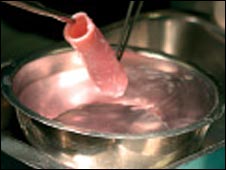In a hospital in Barcelona, researchers were able to develop a trachea from adult stem cells from the patient's body, to avoid rejection

When Castillo Sánchez, a thirty-year-old mother of two from Barcelona, Spain, learned that she had tuberculosis, she began to worry. When her left airway collapsed and became blocked due to the disease, she was already really panicked. And when the doctors couldn't keep it open, she knew her life was in serious danger. The only medical option she had was a new trachea transplant from an organ donor, but that would have been rejected by Sanchez's immune system and would not have survived more than a few days or weeks. The other option - to give Sanchez drugs that would suppress the immune system and allow the implant to exist in the body - was not possible due to her medical history. Based on conservative hospital medicine, Sanchez would have lost her left trachea, and with it any ability to live a normal life, if at all.
The urgent solution emerged from an experiment published in January 2008 and revealed a new way to create organs. The idea is based on taking an organ from a body and 'cleaning' all the cells from it, until only the extracellular skeleton that supported the cells remains. This skeleton cannot cause a hostile immune response in the transplanted person, but it is also useless on its own, without the cells that provide the living factor in the tissue living in it. In a study from January, researchers cleaned a mouse heart until only the extracellular skeleton remained, then seeded new cells onto the dead tissue. The new cells took the places of the vacated old cells, restoring the heart's ability to beat (albeit with much less efficiency).
Despite the great excitement surrounding the success of the experiment, it was hard to believe that it would chart a path for tissue engineering in humans as well in the next decade. Medical science is often afraid of 'leaps' and it seems likely that at least another ten years will pass before the technique enters hospitals.
And here - a surprise, which shows that sometimes it's fun to be wrong. The leading medical journal, The Lancet, published the story of Sanchez's successful recovery yesterday, after the doctors who treated her decided to take drastic measures and try to 'create' a new tube in the laboratory using the method described above.
The doctors used a trachea that came from an organ donation and poured over it all the cells, which would have caused a severe immune reaction in the patient (something that would surely have resulted in her death, due to her poor health). Having only the extracellular skeleton of the tube left in their hands, the researchers seeded it with epithelial cells taken from the patient, which formed the covering tissue of the tube. The researchers also used the patient's mature stem cells, which underwent differentiation in the laboratory into cartilage cells and were seeded into the extracellular skeleton of the tube. The final result was a trachea enriched in cells and ready for transplantation without fear of an immune reaction, because all the cells in the tissue were taken from the patient herself.
After a short growth period in the laboratory, the trachea was implanted in the patient and replaced the collapsed left trachea. According to the researchers' reports, the tube transplant immediately improved the patient's air supply and quality of life. Today, four months after the transplant, the tube is still functioning well mechanically and biologically.
The main researcher in the life-saving experiment is Professor Paolo Macchiarini, head of the department of general thoracic surgery at the 'Hospital Clinic' in Barcelona and the transplant operator. In a press release, Macchiarini and his colleagues announced that the woman is now able to "climb two flights of stairs, walk five hundred meters without stopping and take care of her children." The experts in the field agree that it is necessary to wait six months from the moment of transplantation to verify the effectiveness of the method, but there is no doubt that the situation already bodes well. According to current reports, Sánchez is even able to go dancing at night these days!
Despite the great joy over the one-point success, it is important to say that it is unlikely that the successful transplant will bring significant relief to the plight of organ donations in the near future. In the case of the trachea, it is one of the simplest tissues in the human body, and the day when it will be possible to create and maintain complex tissues such as muscles and bones in the laboratory is still a long way off. The method does have great potential, but these days we are only uncovering the tip of the iceberg and we can only hope that the more budget and research is invested, the faster the future techniques for organ replacement will arrive.

2 תגובות
The opening shot
I guess we also have to free her from tuberculosis.